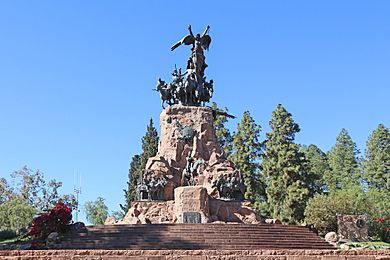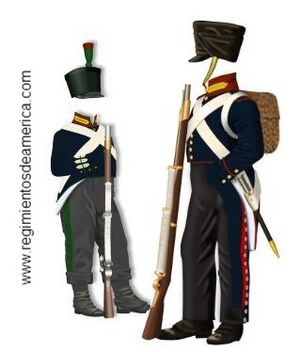Army of the Andes facts for kids
Quick facts for kids Army of the Andes |
|
|---|---|

The Army of the Andes leaving the Plumerillo camp, Museo Histórico Nacional, Buenos Aires.
|
|
| Active | 1816–1817 |
| Allegiance | |
| Type | Army |
| Engagements | Spanish American wars of independence |
| Commanders | |
| Supreme commander | José de San Martín |
| General commander | Bernardo O'Higgins |
| Insignia | |
| Identification symbol |
 |
The Army of the Andes (Spanish: Ejército de los Andes) was a special military group. It was put together by a new country called the United Provinces of the Río de la Plata (which is now Argentina). General José de San Martín led this army. Their big mission was to help Chile become free from the Spanish Empire.
In 1817, the army made an amazing journey. They crossed the Andes Mountains from a part of Argentina called Mendoza. They succeeded in their goal. They pushed the Spanish out of Chile.
Contents
Forming the Army of the Andes
The Army of the Andes was made up of soldiers from Argentina and Chile. There were also about 1,200 helpers. These helpers brought supplies and food. The army also had cannons for fighting.
Historians aren't sure of the exact number of soldiers. Some say there were about 3,500, while others say up to 6,000 men. Even though many soldiers were new to fighting, General San Martín trained them very well. He wanted them to be a proper army, not just a random group.
The Congress of Tucumán (a big meeting in Argentina) agreed with San Martín's plan. They wanted him to form an army to fight the royalists. These royalists were people who supported the Spanish king. From 1814 to 1817, San Martín worked hard to get his troops ready for their tough journey.
Crossing the Andes Mountains
To cross the huge Andes Mountains, the army split into two main groups.
The Main Columns
- The first group was led by General San Martín himself. He was helped by Brigadier Major Miguel Estanislao Soler and Brigadier Bernardo O'Higgins. This group took the Los Patos Pass.
- The second group was led by Colonel Juan Gregorio de las Heras. They took the Uspallata Pass. This pass was easier to travel through. It reached about 12,000 feet (3,650 meters) high! Because it was easier, all the heavy cannons were taken through this second pass.
Smaller Groups
Besides the two main groups, smaller teams were sent to the north and south. These teams helped protect the main army's sides.
- To the north, about 130 soldiers and some Chilean people living away from home formed a group. Juan Manuel Cabot led them.
- To the south, a group was led by the Chilean Ramón Freire Serrano.
Battles and Victory
After a tough 25-day journey across the Andes, the Army of the Andes finally met the royalist forces. This happened at the Battle of Chacabuco. The Army of the Andes won this important battle.
After their victory, they marched into Santiago de Chile, the capital of Chile. Everyone wanted San Martín to become the new leader of Chile. But he said no. He had already decided this and had instructions from Buenos Aires (in Argentina). So, Bernardo O'Higgins was chosen as the new leader instead.
Later, the Chilean army was rebuilt with help from Argentine officers. San Martín was then put in charge of the "United Army." This new army was a mix of the Army of the Andes and Chilean soldiers. This United Army fought against a royalist counterattack led by Mariano Osorio. They fought in the battles of Cancha Rayada and Maipú.
Who Was in the Army of the Andes?
Black Soldiers
A large number of black soldiers were part of San Martín's army. They made up most of the 7th, 8th, and 11th Infantry Regiments. San Martín believed that black soldiers were very good at fighting on foot. About two-thirds of the soldiers in the Army of the Andes were black.
It's thought that between 2,000 and 3,000 black Argentines, who had been freed from slavery, crossed the Andes in 1817. Most of these freedmen were recruited from areas outside the city of Buenos Aires. Sadly, out of these 2,500 black soldiers who crossed the mountains, only 143 returned to Argentina.
At that time, laws usually said that only white people could be officers. But San Martín wanted to change this. He pushed for black soldiers to be promoted to corporals and sergeants. Spanish armies often separated soldiers by race. But San Martín did not like this. He believed that black and white soldiers should fight together in the same groups. Later, the 7th and 8th regiments joined together in Peru to form the black regiment of the Río de la Plata. The 4th Infantry Battalion also became an all-black unit.
Units (1814-1815)
Argentine Units
- Horse Grenadiers Regiment
- Cavalry Militia Regiment
- San Juan Militias Regiment
- Mendoza Militias Brigade
- La Rioja Militias Brigade
- Commander in Chief's Own Mounted Rifles Escorts Squadron
- San Luis Volunteer Cavalry Regiment
- Mendoza Volunteer Cavalry Regiment
- Mendoza Volunteer Artillery Batteries
Chilean Units
- 1st Chilean Infantry Regiment
- Emigrant Battalion of Chilean Line Infantry
- Southern Patriotic Legion of Dragoons
- Chilean Battalion of Artillery
Combined Argentine-Chilean units
- Argentine Auxiliary Battalion

Units (1815-1817)
- 3rd Battalion, Fatherland Regiment of Artillery
- 8th Infantry Battalion
- 11th Infantry Battalion
- 1st Battalion, Andes Rangers and Sharpshooters
- 7th Infantry Battalion
- 4th Infantry Battalion
- Horse Grenadier Regiment
- Commander in Chief's Own Mounted Rifles Escort Squadron
- Río de la Plata Black Regiment (formed in 1816)
See also
 In Spanish: Ejército de los Andes para niños
In Spanish: Ejército de los Andes para niños


